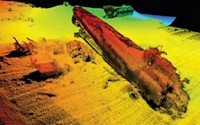Advertisement
Grab your lab coat. Let's get started
Welcome!
Welcome!
Create an account below to get 6 C&EN articles per month, receive newsletters and more - all free.
It seems this is your first time logging in online. Please enter the following information to continue.
As an ACS member you automatically get access to this site. All we need is few more details to create your reading experience.
Not you? Sign in with a different account.
Not you? Sign in with a different account.
ERROR 1
ERROR 1
ERROR 2
ERROR 2
ERROR 2
ERROR 2
ERROR 2
Password and Confirm password must match.
If you have an ACS member number, please enter it here so we can link this account to your membership. (optional)
ERROR 2
ACS values your privacy. By submitting your information, you are gaining access to C&EN and subscribing to our weekly newsletter. We use the information you provide to make your reading experience better, and we will never sell your data to third party members.
Environment
Deepwater Horizon Oil Spill’s Oyster Aftermath
Oil Spill: Isotope data suggest that oysters in spill zone did not consume much oil
by Mark Schrope
November 15, 2012

Oysters exposed to oil during and after the 2010 Deepwater Horizon oil spill did not consume significant quantities of that oil, according to a new study (Environ. Sci. Technol., DOI: 10.1021/es302369h).
One of the enduring questions of the Gulf of Mexico disaster is where the oil ended up. Bacteria broke down much of it into small organic molecules that could fuel the Gulf’s food web, according to previous studies. A team of researchers led by marine scientist Ruth Carmichael at the Dauphin Island Sea Lab, a state-run institution in Alabama, wondered whether the region’s famed oysters might also have been consuming oil.
“What we were really interested in,” says Carmichael, “was whether we could see evidence of oil-derived substances making their way into a commercially harvested species and further up into the food web.”
Before the spill, the researchers had already been working with oysters (Crassostrea virginica) at sites along the Alabama and Mississippi coasts that were then hit with high levels of oil. As a result, they had samples from before, during, and after the spill.
Oysters feed by filtering water through their bodies and removing particles. The team measured the ratios of carbon and nitrogen isotopes of the oysters’ tissue, the oil, and the suspended matter in brackish water that makes up the oysters’ normal diet.
The ratios of these isotopes in oil are distinct from those of the oysters’ normal food. The researchers found that the oysters’ flesh and shells, whose composition reflects their diet, showed no significant shift toward oil’s isotopic signature.
The researchers can’t say whether this result means the oysters closed up when exposed to oil, or that they continued feeding normally and somehow avoided ingesting the oil. But, says Carmichael, “we do know the oil didn’t contribute significantly to their diet.”
Carmichael also points out that oysters still could have been exposed to and harmed by oil in other ways. For instance, they could have absorbed polycyclic aromatic hydrocarbons, the most toxic constituents of oil, into their tissues directly. PAHs can cause health problems such as tumors. Oysters may not break the compounds down in ways that would incorporate them into the tissue type and shells that the study analyzed.
Carmichael says the results could be positive because they suggest the Gulf’s oysters did not have “bellies full of oil.” But she says finding evidence of oil consumption might actually have been a good thing, as well. Such a finding could have shown that the oysters were helping clean up the Gulf ecosystem.
Peter Roopnarine, a geologist at the California Academy of Sciences who studies oil’s effects on oysters and other organisms, says showing definitively that the oysters were not consuming significant amounts of oil is important. “When oysters are coated in oil, so many bad things can happen,” he says. “You like to rule out what’s not happening.”





Join the conversation
Contact the reporter
Submit a Letter to the Editor for publication
Engage with us on Twitter